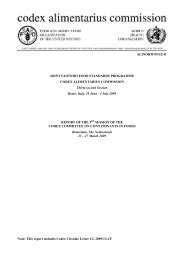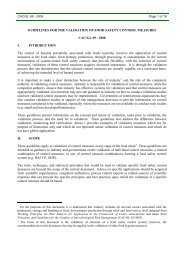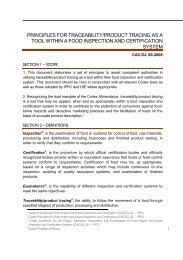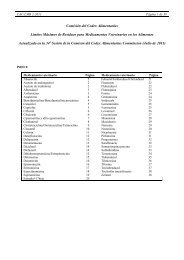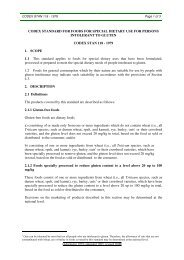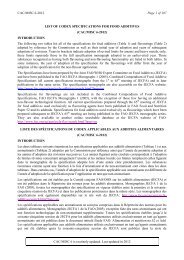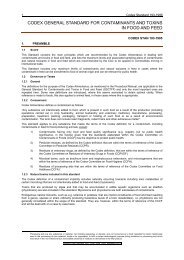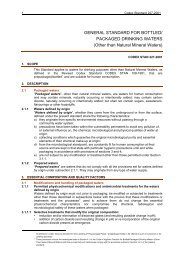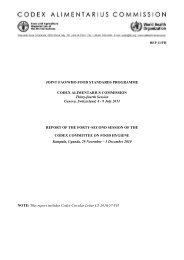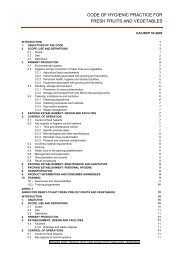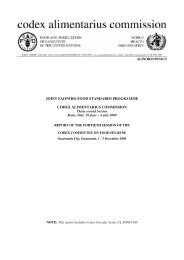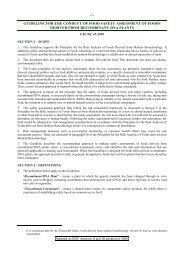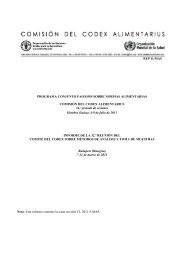General Standard for Food Additives - CODEX Alimentarius
General Standard for Food Additives - CODEX Alimentarius
General Standard for Food Additives - CODEX Alimentarius
Create successful ePaper yourself
Turn your PDF publications into a flip-book with our unique Google optimized e-Paper software.
<strong>CODEX</strong> STAN 192-1995 Page 33 of 287<br />
07.2 Fine bakery wares (sweet, salty, savoury) and mixes:<br />
Includes sub-categories <strong>for</strong> ready-to-eat products (07.2.1 and 07.2.2) as well as mixes (07.2.3) <strong>for</strong> preparing<br />
fine baked goods.<br />
07.2.1 Cakes, cookies and pies (e.g., fruit-filled or custard types):<br />
The term “sweet cracker” or “sweet biscuit” used in this category refers to a cookie-like product that may be<br />
eaten as a dessert. Examples include: butter cake, cheesecake, fruit-filled cereal bars, pound cake (including<br />
kasutera), moist cake (type of starchy dessert (namagashi)), western cakes, moon cakes, sponge cake, fruitfilled<br />
pies (e.g., apple pie), oatmeal cookies, sugar cookies and British “biscuits” (cookies or sweet crackers).<br />
07.2.2 Other fine bakery products (e.g., doughnuts, sweet rolls, scones, and muffins):<br />
Includes products that may be eaten as a dessert or as breakfast. Examples include: pancakes, waffles, filled<br />
sweet buns (anpan), Danish pastry, wafers or cones <strong>for</strong> ice cream, flour confectionery, and trifles.<br />
07.2.3 Mixes <strong>for</strong> fine bakery wares (e.g., cakes, pancakes):<br />
Mixes containing the dry ingredients to which wet ingredients (e.g., water, milk, oil, butter, eggs) are added<br />
to prepare a dough <strong>for</strong> fine baked goods. Examples include: cake mix, flour confectionery mix, pancake mix,<br />
pie mix, and waffle mix. Prepared dough is found in category 07.1.4. Mixes <strong>for</strong> ordinary bakery wares (e.g.,<br />
bread) is found in category 07.1.6.<br />
08.0 Meat and meat products, including poultry and game:<br />
This category includes all types of meat, poultry, and game products, in pieces and cuts or comminuted, fresh<br />
(08.1) and processed (08.2 and 08.3).<br />
08.1 Fresh meat, poultry and game:<br />
Fresh products are usually free of additives. However, in certain circumstances, additives are necessary. For<br />
example, colours are used <strong>for</strong> certification stamps on the surfaces of fresh cuts of meat, and are indicated in<br />
the FCS with a notation <strong>for</strong> “stamping, marking or branding the product.” Additionally, coatings, such as<br />
glazes and spice rubs, may be applied to meat products prior to marketing to the consumer (e.g., glazed ham,<br />
and barbecued chicken). In the FCS, this is indicated with a notation <strong>for</strong> “use as a glaze or coating (surface<br />
treatment).” It should be noted that the coatings marketed per se are included in food categories 04.1.2.8<br />
(fruit-based glazes, e.g., <strong>for</strong> ham) and 12.2 (spice rubs).<br />
08.1.1 Fresh meat, poultry and game, whole pieces or cuts:<br />
Untreated raw meat, poultry and game carcasses and cuts. Examples include: beef, hog and pork carcasses;<br />
fresh beef blood; fresh whole chickens and chicken parts; fresh beef cuts (e.g., steaks); beef organs (e.g.,<br />
heart, kidney); fresh tripe; and pork chops.<br />
08.1.2 Fresh meat, poultry and game, comminuted:<br />
Untreated raw comminuted or mechanically deboned meat, poultry and game. Examples include: fresh beef<br />
(hamburger) patties; boerewors; fresh breakfast sausages; gehakt (chopped meat); loganiza (fresh, uncured<br />
sausage); fresh meatballs; mechanically deboned, ground and <strong>for</strong>med poultry pieces (with or without<br />
breading or coating); and fresh sausages (e.g., beef, Italian, and pork).<br />
08.2 Processed meat, poultry, and game products in whole pieces or cuts:<br />
Includes various treatments <strong>for</strong> non-heat treated meat cuts (08.2.1) and heat-treated meat cuts (08.3.2).<br />
08.2.1 Non-heat treated processed meat, poultry and game products in whole pieces or cuts:<br />
This category describes several treatment methods (e.g., curing, salting, drying, pickling) that preserve and<br />
extend the shelf life of meats.<br />
08.2.1.1 Cured (including salted) non-heat treated processed meat, poultry, and game products in whole<br />
pieces or cuts:<br />
Salted products are treated with sodium chloride. Dry cured (dry pickled) products are prepared by rubbing<br />
salt directly on the meat surface. Wet pickle cured products are prepared by submerging the meat in a brine<br />
solution. Pump cured products are prepared by injecting brine into the meat. Curing may also be achieved by



